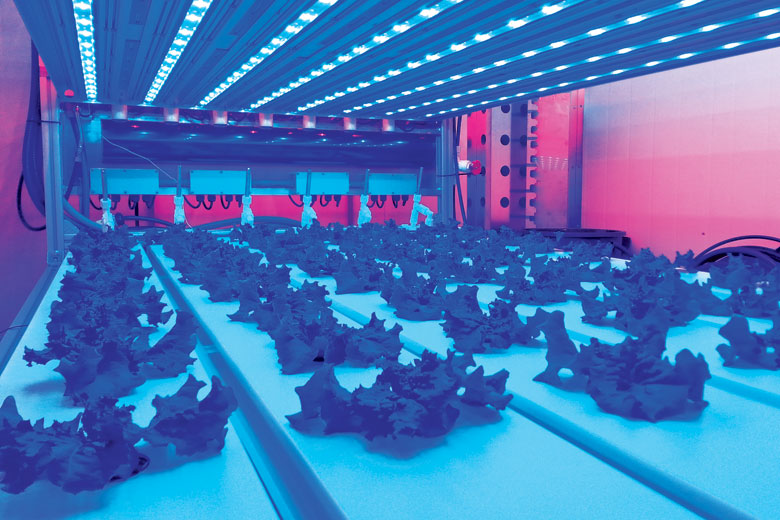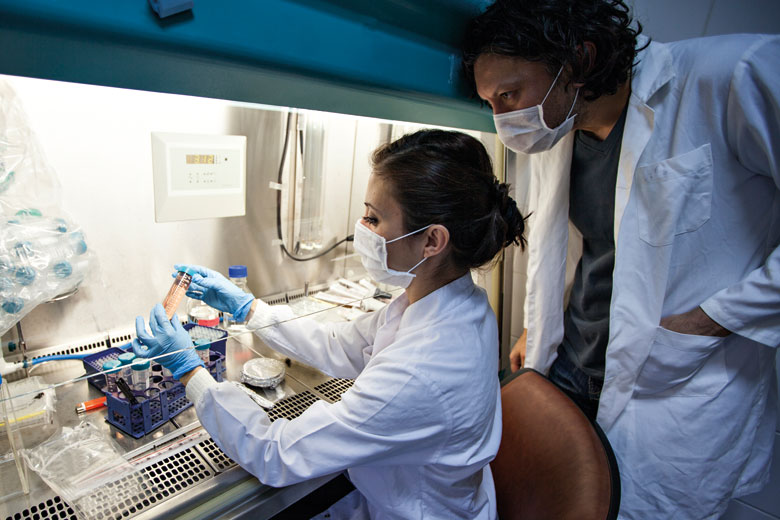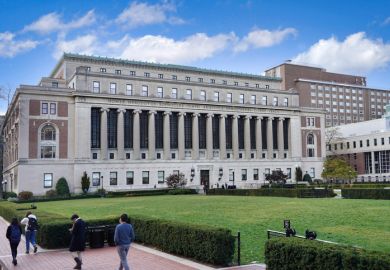Under blue, red and green light-emitting diodes in vast, fridge-like pressurised boxes may lie a significant contributor to Canada’s economic future. At the University of Guelph, about an hour’s drive west of Toronto, senior research associate Mike Stasiak and his team are working out how to grow plants sustainably on the Moon.
Scientists originally assumed that settlers on a Moon colony would just eat algae, which is relatively easy to grow, he explains. But doing that, “you’d go crazy”, he points out, not least because living among greenery has huge psychological benefits, which is why “astronauts fight over who gets to look after the plants in space”.
The lab is well on the way to cracking this problem, and radishes, lettuce, soybeans and wheat have all sprouted in Stasiak’s lowpressure, multi-coloured growing boxes. He has also been experimenting with the effects of different colour LEDs on vegetable growth: under blue lights, lettuces grow red; under red LEDs, they turn out green.
Although this research is designed to help future Moon-dwellers, it also has more immediate benefits on Earth. The technology involved can be used to grow food using far less water, and the lab is working with a number of firms to create a facility in Kuwait. It has spun out a company to create indoor, breathable walls that remove pollutants from the air. It could also help communities in Canada’s remote Arctic regions to grow more of their own fresh vegetables.
This is research commercialisation: the translation of university breakthroughs into the real economy. After years of antagonism between scientists and the Conservative government of Stephen Harper, Canada’s new Liberal administration is trying a more collaborative approach. It is also trying to figure out why Canada lags behind other more innovative countries, and what can be done about it.
Canada is not alone in its concern to get this right. In an era of anaemic economic growth, inequality and rising populism, Canada is just one of many countries turning to university research to revive their economies. The dilemmas facing Justin Trudeau’s government, which is now almost a year old, are also keeping civil servants awake at night in London, Beijing, Seoul and Canberra.
In the UK, the new prime minister, Theresa May, has said that she wants a “proper industrial strategy” to rejuvenate the economy, and recent comments by the business secretary, Greg Clark, indicate that scientific prowess and high-tech firms in university cities will play a key part in this.
Meanwhile in China, where growth is slowing and the population is ageing, President Xi Jinping emphasised in a speech in June that he wants China to become a “leading power” in science and technology by mid-century in order to maintain economic expansion. South Korea is also pouring money into research and development, including artificial intelligence, to avert an economic slowdown.
The Australian government, fearing that it lags behind other rich countries when it comes to collaboration between universities and businesses, launched a new National Innovation and Science Agenda last December. It includes plans to measure the economic and social impact of research, as the UK did in the 2014 research excellence framework, although it remains unclear whether any funding will be linked to the outcomes.
Some economic historians have expressed scepticism about the ability of university-based scientific research to drive growth (see ‘A good bet? Can university research deliver the payoff?’ box below). Furthermore, omens of deep economic discontent, such as the popularity of the US Republican presidential candidate Donald Trump, have led some scientists to warn that the long-standing model of curiosity-driven science – which is assumed to lead eventually to useful real-world applications – has not brought promised benefits to ordinary people.
The technological revolutions that science has thrown up have “contributed to more than 40 years of wealth inequality, disappearing middle-class jobs and eviscerated manufacturing communities in the places where support for Trump is strongest”, wrote Daniel Sarewitz, co-director of the Consortium for Science, Policy and Outcomes at Arizona State University in the 3 August edition of Nature. “Policymakers should seriously consider what a system of socially responsible and responsive science would look like. The current system has failed the test.”
Indeed, Canada’s new innovation strategy, which was launched in June and is now being fleshed out through consultation, appears to acknowledge this failure. It stresses that innovation must improve the lives “of all Canadians” and focus on “strengthening the middle class by creating jobs”.
The strategy does not envisage tying university funding to impact metrics. However, fortunately for the Canadian government, the country’s universities already appear to be fizzing with different ideas and commercialisation approaches to choose from. “We firmly believe that basic science and science excellence are absolutely essential for innovation, for finding new solutions,” says Navdeep Bains, minister of innovation, science and economic development. “The real issue, though, is how do you take those ideas from the lab and how do you take them to the market?”
Canada’s university leaders acknowledge the problem. There is “a widespread feeling that we aren’t playing at the top of our game compared to economic competitors” in terms of innovation, says Malcolm Campbell, vice-president for research at Guelph.
“Innovation” is a nebulous term and impossible to capture in a single metric. But the surveys that try to do so support Campbell’s assessment. The 2016 Global Innovation Index, which includes just about every possible metric in areas including patents, education levels and the ease of getting credit, ranks Canada 15th globally – not bad, but well behind the UK (third), the US (fourth) and Germany (10th).
But asked to identify the problem, Campbell replies: “If you have 10 people in the room, they will have 10 different opinions.”
However, the tide does seem to have turned against the approach of the previous Conservative government, which Campbell says treated academics as a “concierge” service for business. “With the last government, the emphasis was locked on corporate good”, and academia was seen as just “need[ing] to figure out a way to help”. When the Harper government announced a C$1.5 billion (£880 million) science funding programme in late 2014, it was criticised for being overly focused on applied areas of “strategic importance” to Canada.
This view is echoed in labs across the country. At the University of Ontario Institute of Technology, Bradley Easton, an associate professor of chemistry, is part of a team working on a way to reduce the amount of costly platinum needed in fuel cells. A commercial partnership with the fuel cell company Ballard Power was made possible by an Engage Grant, an award of up to C$25,000 from the Natural Sciences and Engineering Research Council of Canada that is designed to get industrial alliances off the ground.

One of the Harper government’s mistakes, he says, was to see commercialisation as a one-way street. “There was certainly a need to get academia engaged with industry, but you also have to get industry engaged with academia,” he says. Instead, the attitude towards businesses was “here are our academics, let them serve you”.
Although the research should eventually help Ballard Power to create a new fuel cell for cars, it also allows Easton to do plenty of “interesting science” without immediate commercial applications.
“If there’s too much emphasis on [commercialisation] work, you’re looking only three to five years ahead,” he says. But the project is also focused on creating an ethanol fuel cell – as opposed to the current hydrogen-fuelled ones – which is a much longer-term prospect, perhaps 20 years away.
If a breakthrough in the lab has commercial potential, the dilemma for universities is how much intellectual property they should claim for themselves. Seizing too much control over an academic’s work might put them off trying to take it to market at all; taking too little could lead to accusations that publicly funded research has led only to private profits.
At the University of Waterloo, alma mater of numerous figures in Silicon Valley tech firms, lab leader Frank Gu is working on a nanotechnology powder that can use sunlight to clean up the toxic compounds left in the water used in oil sands extraction. Once the powder has done its work, the water is so clean that it can be drunk – as demonstrated by Gu in front of a sceptical oil executive.
At Waterloo, the university gets no share of academics’ intellectual property, Gu explains. “People can create their companies…without having to go through the university as a clearance.”
This contrasts with the Massachusetts Institute of Technology, for example, where Gu worked as a postdoc. There, IP belongs to the university if in developing it staff or students made “significant” use of MIT funds or facilities, or if MIT is a party to sponsored research. At Waterloo, Gu says: “I’m the one who holds the final step.”
Some advocates for this laissez-faire system suggested to Times Higher Education that if a student or an academic makes millions out of their invention, they are quite likely to give something back to their alma mater voluntarily. Mike Lazaridis, the founder of BlackBerry, dropped out of Waterloo shortly before graduation, armed with a contract with General Motors and a student venture grant from the provincial government.
His company went on to become a huge player in the early years of the smartphone revolution, and he later rewarded Waterloo by donating more than C$100 million to help found the university’s Institute for Quantum Computing.
A similar approach is being tried at the University of Toronto’s Impact Centre, which since 2010 has helped students to launch 108 start-ups, of which 40 are said to still be “really active”, according to Cynthia Goh, the centre’s director. Students keep full ownership of any ideas they develop. The university takes a 25 per cent cut of the equity or licence value of a product if it has emerged out of a university grant, although even this is negotiable.
“The university tries to have a bigger vision than the immediate return,” she says. Products emerging from the centre include fish feed made from insects – a solution the inventors say is far more ecologically sound than the current method of using other fish – and a nanotechnology spray that helps to boost the performance of solar panels by keeping them clean.
But in Quebec, Canada’s francophone-majority province, there is a much more communal approach. Instead of individual university technology transfer offices, the task of commercialisation is handled by just one organisation, Univalor. Most academics use this organisation, explains Jacques Simoneau, president and chief executive, and even if they decide not to, half their intellectual property always resides with their university anyway.
Univalor does not take an ownership stake; it just manages the commercialisation, attracting funders, conducting market research and devising a business plan.
Giving full control of intellectual property to students and academics and then expecting a big donation after they have made their fortune is a “policy of hope”, according to Simoneau, not least because the culture of alumni philanthropy is much weaker in Canada than it is in the US, he argues.
Simoneau, whose background is in venture capital, also points to another problem afflicting Canadian research commercialisation: funding. One of the reasons that Quebec’s universities have centralised technology transfer in Univalor is to develop the critical mass that they need to attract investors to come and look at what is on offer.
Nowadays, if an institution doesn’t have “access to about C$500 million of research a year”, it is “probably too small…to generate enough interest on the outside”, he says.
Another initiative being pioneered in Quebec to help companies access useful research generated by universities – the College Centres for the Transfer of Technologies – is described in the 'Small-scale invention: College Centres for the Transfer of Technologies' box, below.
Across Canada, a common concern is that the country lacks the venture capital required to get university ideas off the ground. Toronto is ranked 12th among the world’s top 20 cities for venture capital investment in a recent list compiled by the University of Toronto’s Martin Prosperity Institute. But in truth, the US still dominates: Toronto attracted only about 6 per cent of the money that flows into the Bay Area around San Francisco, and just a fifth of the amount that headed to Boston.
“We’re really good at starting up companies as a nation, but we really need to focus on [how to] scale up,” says Bains. “Patient capital” is needed, and the government has launched a programme to incentivise venture capitalists to make these kinds of long-term investments.
But anxieties that venture capitalists in Canada are slow off the mark, or simply too timid, often end up morphing into more general fears that Canadians simply are not as entrepreneurial as those south of the border. “The challenge is…[that] the Canadian players are not as aggressive as in Silicon Valley,” says Sushanata Mitra, associate vice-president for research at York University. “We want to wait and see what happens” rather than take a risk, he thinks.
This perceived cultural obstacle to research commercialisation, as difficult as it is to measure, is perhaps Bains’ greatest challenge of all. It may be that national culture and attitudes are more important to innovation than any tinkering with IP policy, federal grants or capital availability, he acknowledges.
“I do believe that we can have all the strategies we want, but if we don’t create a true culture of innovation, we will have challenges,” he says. “We’re really trying to create innovation as a Canadian value.” Even if governments are able to affect such things, Canada is only at the beginning of a decades-long transition.

A good bet? Can university research deliver the payoff?
Are governments right to rely on science-based innovation to get their economies motoring? Some of the world’s most influential economic historians are doubtful.
Robert Gordon, an economics professor at Northwestern University and author of The Rise and Fall of American Growth, a vast and highly influential history of US living standards published earlier this year, told Times Higher Education that although he is in favour of government-backed university research (not least because of the prospect of new medical cures), it is not “any kind of panacea to create another productivity growth revival”.
Gordon’s central argument is that, from 1870 to 1970, Americans enjoyed a revolutionary jump in their standard of living as the result of the emergence of “once only” developments such as the harnessing of electricity and the invention of the internal combustion engine, which provided an possibly unrepeatable century of productivity growth.
The heroes of his story are inventor-entrepreneurs such as Thomas Edison, and later corporate research divisions including AT&T’s legendary Bell Labs (which invented the transistor), with universities playing only a small part.
Stanford University and the University of California, Los Angeles get a mention in the history of the early internet, but Gordon stresses that the information technology revolutions that triggered a temporary productivity revival between 1996 and 2004 “were not the creations of university research”.
Deirdre McCloskey, professor of economics, history, English and communication at the University of Illinois at Chicago, arguably sits at the other end of the optimism scale from Gordon, and stresses in her work the vast enrichment that humanity has enjoyed over the past three decades thanks to the flowering of new ideas and innovations.
But she also is highly sceptical that university research is a good pump-primer for economic growth. “University research is an exceptionally poor way of ‘generating’ ideas for market-tested betterments. Profit-making businesses are good at it, and are punished if they are not,” she tells THE.
She argues that the writings of Thomas Aquinas proved “more relevant to the economy, being astonishingly relevant ethical analysis, than perhaps 99 per cent of university research in maths, 85 per cent in science, 50 per cent in engineering, and 30 per cent in technology”. University research is hugely valuable because it advances human knowledge, but very little has economic relevance, she thinks.
Why, then, are governments pinning their hopes on science-driven growth? “Some of it is wishful thinking, some of it is because it’s the only lever they can pull,” says Kieron Flanagan, senior lecturer in science and technology policy at the University of Manchester.
Instead, the economic contribution of universities, he thinks, is to produce students who can “solve problems and think for themselves”. What type of basic science a country pursues matters little – the important point is that it provides scientists and engineers for the broader economy, he adds.
Small-scale invention: College Centres for the Transfer of Technologies
One commercialisation technique that the Canadian government is keen to expand is the system of College Centres for the Transfer of Technologies (CCTTs), a network of 49 outposts spread across Quebec.
CCTTs use the latest university research to help small and medium-sized enterprises (SMEs) come up with relatively low-tech solutions to problems, explains Nancy Déziel, general manager of the National Centre in Electrochemistry and Environmental Technologies, a centre based in Shawinigan, northeast of Montreal.
This can make the centre much more useful and quicker to respond to small firms than universities themselves, which by contrast always want to make big, exciting breakthroughs, she says. A typical problem for an SME – finding a new type of glue to use during manufacture, say – is “too basic” and “too boring” for a university.
Déziel recounts a time when she visited the laboratory of a well-known university researcher and took a look in the freezer, where she spotted that they had created a new hydrophobic compound that could be used to improve meat or cheese preservation. “I said: ‘Oh my God…my customers want that. Are you interested to transfer it?’”
But the researcher had moved on to other work and was not interested in commercialisation. It had cost the government C$3 million (£1.75 million) to fund this research, Déziel points out, but it was just sitting in the freezer.
CCTTs have their own labs, which enables them to test practical applications for the latest research. “We scan what they do in university, take the best, adapt it for industry,” Déziel says.
One apple-growing firm came to a centre with a simple but costly problem: about half their apples were falling to the ground before being picked, meaning that they could not be sold, she recalls.
The CCTT developed a syrup, which is now on the market, using these windfall apples. Déziel thinks a university might have come up with a much more complex solution – like extracting the sugar and putting it in biofuels – whereas the centre created a process that the company could afford to implement.
There are 40 similar centres in other provinces, known as Technology Access Centres, and the federal government wants to expand this number to 200 over the next decade. “It’s a very successful model,” says Navdeep Bains, Canada’s minister of innovation, science and economic development.
POSTSCRIPT:
Print headline: Growth medium
Register to continue
Why register?
- Registration is free and only takes a moment
- Once registered, you can read 3 articles a month
- Sign up for our newsletter
Subscribe
Or subscribe for unlimited access to:
- Unlimited access to news, views, insights & reviews
- Digital editions
- Digital access to THE’s university and college rankings analysis
Already registered or a current subscriber? Login








